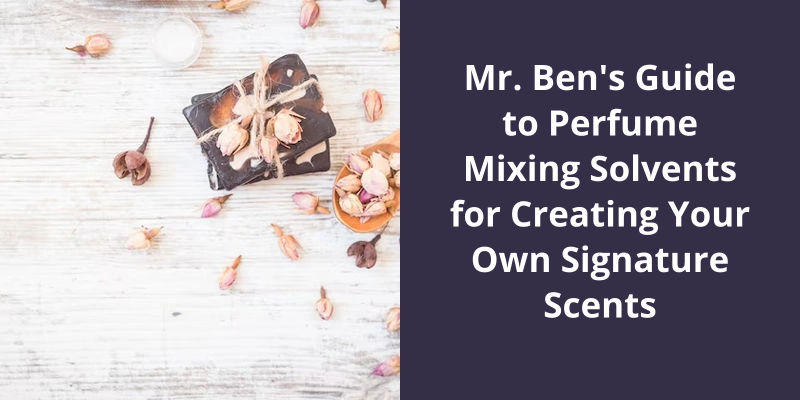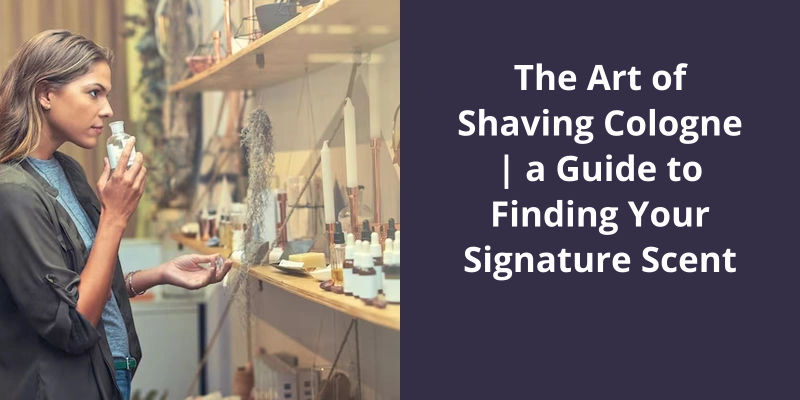Mr. Ben’s Guide to Perfume Mixing Solvents offers practical insights about making your own unique fragrances. It enlightens on the importance of applying the correct solvents, a crucial aspect of perfume creation. The guide reviews solvents like alcohol and oil, which are vital for the dilution of essential oils and aroma chemicals. Mr. Ben elaborates how choosing the right solvent significantly affects the final product’s smell, longevity, and diffusion, guiding readers to design signature scents that truly reflect their personal style. Appropriately mixed solvents act as wonderful carriers for the scent ingredients, allowing for a smooth, lasting, and amplified fragrance. Hence, understanding solvents and their proper application becomes instrumental for creating personalized perfumes.

What Is the Main Solvent in Perfume?
Perfume is a popular accessory used by people all over the world to add a pleasant fragrance to their bodies. But have you ever wondered what the main solvent in perfume is? The answer is alcohol. Typically, the alcohol used in perfumes is a mixture of ethanol and water or a rectified spirit. This solvent is used to dilute the concentrated perfume oil and make it suitable for use on the skin.
This solvent is derived from natural sources such as corn, wheat, and sugarcane. Ethanol has a low boiling point, which makes it easy to evaporate and distribute the fragrance evenly.
Water is typically added in small quantities to the alcohol to dilute the fragrance and make it milder. This is done to ensure that the fragrance doesn’t overpower the senses. In perfumery, it’s important to strike a balance between the strength of the fragrance and it’s subtleties.
While other neutral-smelling oils and liquid waxes can also be used as solvents, they aren’t as commonly used as alcohol and water. The selection of solvent depends on the type of fragrance, it’s strength, and it’s intended use.
Solvent extraction is a widely adopted technique for obtaining pure and potent perfumes. This process contributes to creating perfumes with more depth and complexity as a plant’s essence dissolves completely in volatile solvents. This article sheds light on different aspects of solvent extraction and it’s importance in the fragrance industry.
What Is Solvent Extraction of Perfumes?
Solvent extraction of perfumes is a technique that’s widely used in the fragrance industry to extract fragrances from plant materials. The process involves the use of solvents to dissolve the essential oils, aroma compounds, and other fragrant compounds that make up the scent of the plant. The solvent is then separated from the fragrant material using evaporation, leaving behind a concentrated fragrance that can be used in perfumes, soaps, and other scented products.
In solvent extraction, the choice of solvent is critical. The solvent needs to be able to dissolve the fragrant compounds in the plant material, but it must also be non-toxic and non-reactive. However, the use of certain solvents, such as petroleum ether or chloroform, has been phased out due to concerns over their impact on the environment and human health.
This method allows for a more precise scent profile and can create fragrances that are much more complex than those created using simple distillation methods.
For example, some fragrant compounds in flowers and spices can be damaged or destroyed by the high temperatures used in steam distillation.
While the process can be complex and time-consuming, it’s an essential tool for perfumers who need to create precise and complex scents.
As the demand for non-alcoholic perfumes increases, manufacturers are continually searching for alternative solvents. One such option is isopropyl myristate, a polar emollient typically found in topical pharmaceuticals and cosmetic preparations. IPM is virtually odorless and is used in non-alcoholic skin perfumes as a replacement for ethanol. It’s versatility extends beyond cosmetics, as it’s also used in flea and tick products for pets and as a treatment for head lice.
What Is Non Alcoholic Solvent for Perfume?
In the manufacturing of perfumes and other fragrances, finding the right solvent is crucial. Solvents dissolve the fragrant ingredients and allow them to be diffused into the air. Non-alcoholic solvents have been gaining popularity due to the health and safety concerns associated with traditional alcohol-based solvents. Isopropyl myristate is one such non-alcoholic solvent that’s used extensively in cosmetic and topical pharmaceutical preparations where skin absorption is desired.
This makes it an excellent solvent for fragrant ingredients that can be both hydrophilic and lipophilic. It’s a low viscosity and low surface tension, making it easy to spread and blend. Moreover, it’s virtually odourless, making it an excellent solvent for skin-perfumes that don’t have an alcohol base.
It also finds applications in topical pharmaceutical preparations, such as anti-inflammatory gels and creams. Additionally, it’s used as a treatment for head lice and as an ingredient in flea and tick killing products for pets.
Moreover, non-alcoholic solvents are less drying and don’t leave behind any residue, making them a safer and healthier choice for skincare products.
When it comes to wearing fragrance oils, diluting them with a carrier oil or non-scented lotion is crucial. Not only does it make your scent last longer, but it also ensures that the fragrance isn’t too overpowering. Here’s a quick guide on how to dilute perfume oil with a carrier oil or lotion.
What Do You Dilute Perfume Oil With?
If youre a perfume lover, you might be interested in diluting your fragrance oils to maximize their potential. One option is to use a carrier oil, and the other is to use a non-scented lotion. Both of these options offer a variety of benefits and play a crucial role in creating a pleasing scent that lasts all day long.
The process of diluting perfume oil with lotion is simple. All you need is a quarter-sized amount of lotion and 1-2 drops of your favorite fragrance oil. Blend the lotion and fragrance oil together between your hands and apply directly on your skin. Not only does this create a lovely and lasting scent, but it also moisturizes and nourishes the skin.
First, be sure to use high-quality fragrance oils that are appropriate for the intended use. Second, ensure that you’re diluting correctly and with the right portion of carrier oil or lotion. Lastly, make sure to store your diluted fragrance oil in an airtight container to protect it from damaging light and air.
Regardless of which method you choose, make sure to be mindful of key factors such as the quality of the fragrance oil and the method of dilution. By following these guidelines, creating your very own fragrance masterpiece is sure to be a success.
Perfumes are a blend of fragrant oils and compounds typically diluted in a solvent. But what’s the solvent for perfume oil? One common solvent is turpentine, a fluid extracted from living trees that’s also used for organic synthesis. Other solvents used in perfume production include terpineol and D-limonene, both derived from natural sources such as turpentine and orange oil. These solvents play a crucial role in making perfume oils and compounds blend seamlessly, creating the aromatic scents we all know and love.
What Is the Solvent for Perfume Oil?
The production of perfume isn’t only an art, but it also requires scientific knowledge. One of the crucial components of perfume is the solvent, which is responsible for diluting and dispersing the fragrant oils. However, one of the most popular solvents is pure terpene oil.
Terpineol is a type of monoterpenoid alcohol that’s extracted from various sources, including pine oil, cardamom, cajuput oil, and petitgrain oil. Terpineol is highly valued in the perfume industry because of it’s sweet, floral aroma, which complements many fragrances.
In some cases, solvents such as alcohol, glycerol, and propylene glycol may also be used. However, natural solvents are highly preferred to synthetic ones because they tend to be more compatible with the fragrant oils, resulting in a more natural and authentic perfume.
Conclusion
In conclusion, the art of perfume mixing is a delicate and intricate process that requires precision, patience, and expertise. Through his innovative approach and attention to detail, Mr. Ben has elevated the standard of perfumery and continues to inspire others in the industry. His legacy serves as a reminder of the limitless possibilities that exist in the world of fragrance and underscores the importance of creativity, experimentation, and dedication in this timeless art form.





